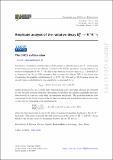Amplitude analysis of the radiative decay B0s → K+K−γ
Author(s)
Aaij, R.; Abdelmotteleb, A. S. W.; Abellan Beteta, C.; Abudinén, F.; Ackernley, T.; Adefisoye, A. A.; Adeva, B.; Adinolfi, M.; Adlarson, P.; Agapopoulou, C.; Aidala, C. A.; Ajaltouni, Z.; Akar, S.; Akiba, K.; Albicocco, P.; Albrecht, J.; ... Show more Show less
Download13130_2024_Article_24227.pdf (2.478Mb)
Publisher with Creative Commons License
Publisher with Creative Commons License
Creative Commons Attribution
Terms of use
Metadata
Show full item recordAbstract
A search for radiative decay of 𝐵0𝑠
mesons to orbitally excited K+K− states is performed using proton proton collisions recorded by the LHCb experiment, corresponding to an integrated luminosity of 9 fb−1. The dikaon spectrum in the mass range mKK < 2400 MeV/c2 is dominated by the ϕ(1020) resonance that accounts for almost 70% of the decay rate. Considering the possible contributions of f2(1270), 𝑓′2
(1525) and f2(2010) meson states, the overall tensor contribution to the amplitude is measured to be
{𝑓2}=16.8±0.5(stat.)±0.7(syst.)%,
mostly dominated by the 𝑓′2
(1525) state. Several statistically equivalent solutions are obtained for the detailed resonant structure depending on whether the smaller amplitudes interfere destructively or constructively with the dominant amplitude. The preferred solution that corresponds to the lowest values of the fit fractions along with constructive interference leads to the relative branching ratio measurement
(𝐵0𝑠→𝑓′2𝛾)(𝐵0𝑠→𝜙𝛾)=19.4+0.9−0.8(stat.)+1.4−0.5(syst.)±0.5()%,
where the last uncertainty is due to the ratio of measured branching fractions to the K+K− final state. This result represents the first observation of the radiative 𝐵0𝑠→𝑓′2(1525)𝛾
decay, which is the second radiative transition observed in the 𝐵0𝑠
sector.
Date issued
2024-08-13Department
Massachusetts Institute of Technology. Department of PhysicsJournal
Journal of High Energy Physics
Publisher
Springer Berlin Heidelberg
Citation
Journal of High Energy Physics. 2024 Aug 13;2024(8):93
Version: Final published version